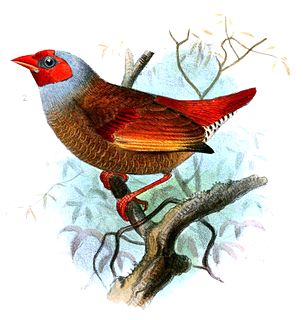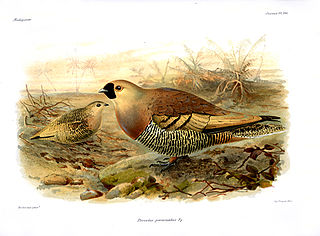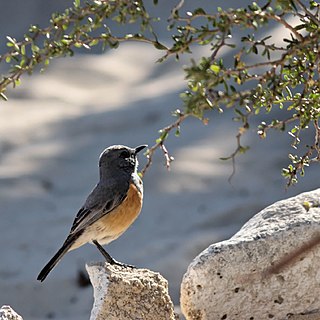
The fieldfare is a member of the thrush family Turdidae. It breeds in woodland and scrub in northern Europe and across the Palearctic. It is strongly migratory, with many northern birds moving south during the winter. It is a very rare breeder in the British Isles, but winters in large numbers in the United Kingdom, Southern Europe, North Africa and the Middle East. It is omnivorous, eating a wide range of molluscs, insects and earthworms in the summer, and berries, grain and seeds in the winter.

The isabelline wheatear is a small passerine bird that was formerly classed as a member of the thrush family Turdidae, but is now more generally considered to be an Old World flycatcher in the family Muscicapidae. It is a migratory insectivorous bird. Its habitat is steppe and open countryside and it breeds in southern Russia and Central Asia to northern Pakistan, wintering in Africa and northwestern India. It is a very rare vagrant to western Europe.

The family Vangidae comprises a group of often shrike-like medium-sized birds distributed from Asia to Africa, including the vangas of Madagascar to which the family owes its name. Many species in this family were previously classified elsewhere in other families. Recent molecular techniques made it possible to assign these species to Vangidae, thereby solving several taxonomic enigmas.

The helmet vanga is a distinctive-looking bird of the vanga family, Vangidae, and is classified in its own genus, Euryceros. It is mainly blue-black, with rufous wings and a huge arched blue bill. It is restricted to lowland and lower montane rainforests of northeastern Madagascar. Its diet is composed of invertebrates, predominantly insects. The species is threatened by habitat loss.

The African pygmy goose is a perching duck from sub-Saharan Africa. It is the smallest of Africa's wildfowl, and one of the smallest in the world.

The orange-winged pytilia, also known as the golden-backed pytilia, is a species of estrildid finch found in Africa. It has a wide range and the International Union for Conservation of Nature has assessed it as being of least concern.

Brehm's tiger parrot, also known as Brehm's ground parrot, is a small mainly green parrot found in the highlands of New Guinea, from 1,500-2,600m. The species is named after Alfred Brehm (1829–1884), a German traveller and collector.

The white-breasted parakeet or white-necked parakeet is a species of parrot in the family Psittacidae. It is found in southern Ecuador and adjacent northern Peru.

The Comoros blue pigeon is a species of bird in the family Columbidae. It is endemic to the Comoros and the coralline Seychelles. It is rated as a species of near threatened on the International Union for Conservation of Nature Red List of Endangered Species.

The Madagascan sandgrouse is a species of bird in the family Pteroclidae. It is endemic to Madagascar and is a ground-dwelling short-legged plump bird. The head of the male is brown with a black area surrounding the beak. He has a pinkish-buff coloured breast, a light brown mottled back, brown wings and paler underparts barred with dark brown. The female has a generally duller appearance being cryptically coloured brown with dark specks and bars.

The red-tailed vanga is a species of bird in the family Vangidae. It is endemic to Madagascar.

The rufous-tailed palm thrush is a species of bird in the family Muscicapidae.

The white-browed robin-chat, also known as Heuglin's robin, is a species of bird in the family Muscicapidae. Found in east, central and southern Africa, its natural habitats include riverine forest and thickets, and it is also found near humans. The IUCN classifies it as a least-concern species.

The blue vanga is a bird species in the family Vangidae. It is in the monotypic genus Cyanolanius. It is found in Comoros, Madagascar, and Mayotte, where its natural habitats are subtropical or tropical dry forest and subtropical or tropical moist lowland forest.

The bearded scrub robin, also known as the eastern bearded scrub robin, is a species of bird in the family Muscicapidae. It is found in eastern and southern Africa.

The sickle-billed vanga is a species of bird in the vanga family Vangidae. It is monotypic within the genus Falculea. It is endemic to Madagascar. Its natural habitats are tropical dry forests and tropical dry shrubland.

The littoral rock thrush, is a species of bird in the family Muscicapidae. It is endemic to Madagascar.

Archbold's newtonia is a species of bird in the family Vangidae. It is endemic to Madagascar. Its natural habitats are subtropical or tropical dry forests and subtropical or tropical dry shrubland. The birds have a greyish brown back and tail, with a rufous forecrown and a buffy white belly, throat, and undertail coverts. They have a conspicuous rufous eye-ring, accompanied with a black bill and pale yellow eyes. The species is sexually monomorphic, and there is no major difference between the sexes. There is no breeding plumage for the males.

Lafresnaye's vanga is a species of bird in the vanga family Vangidae. The species is monotypic and one of three species in the genus Xenopirostris. It is endemic to the south and south west of Madagascar. It inhabits sub-arid thorn scrub, in the Madagascar spiny forests ecoregion, particularly areas with large amounts of dead wood, from sea level to 100 m (330 ft). The species has a small range and is not common within that range, but is not thought to be endangered and is listed as Least Concern by the IUCN.

The Aztec thrush is a species of bird in the family Turdidae. It is found mainly in Mexico, but vagrants are occasionally seen in the United States. Its natural habitat is montane forests. The IUCN Red List denotes it as a least-concern species.





















